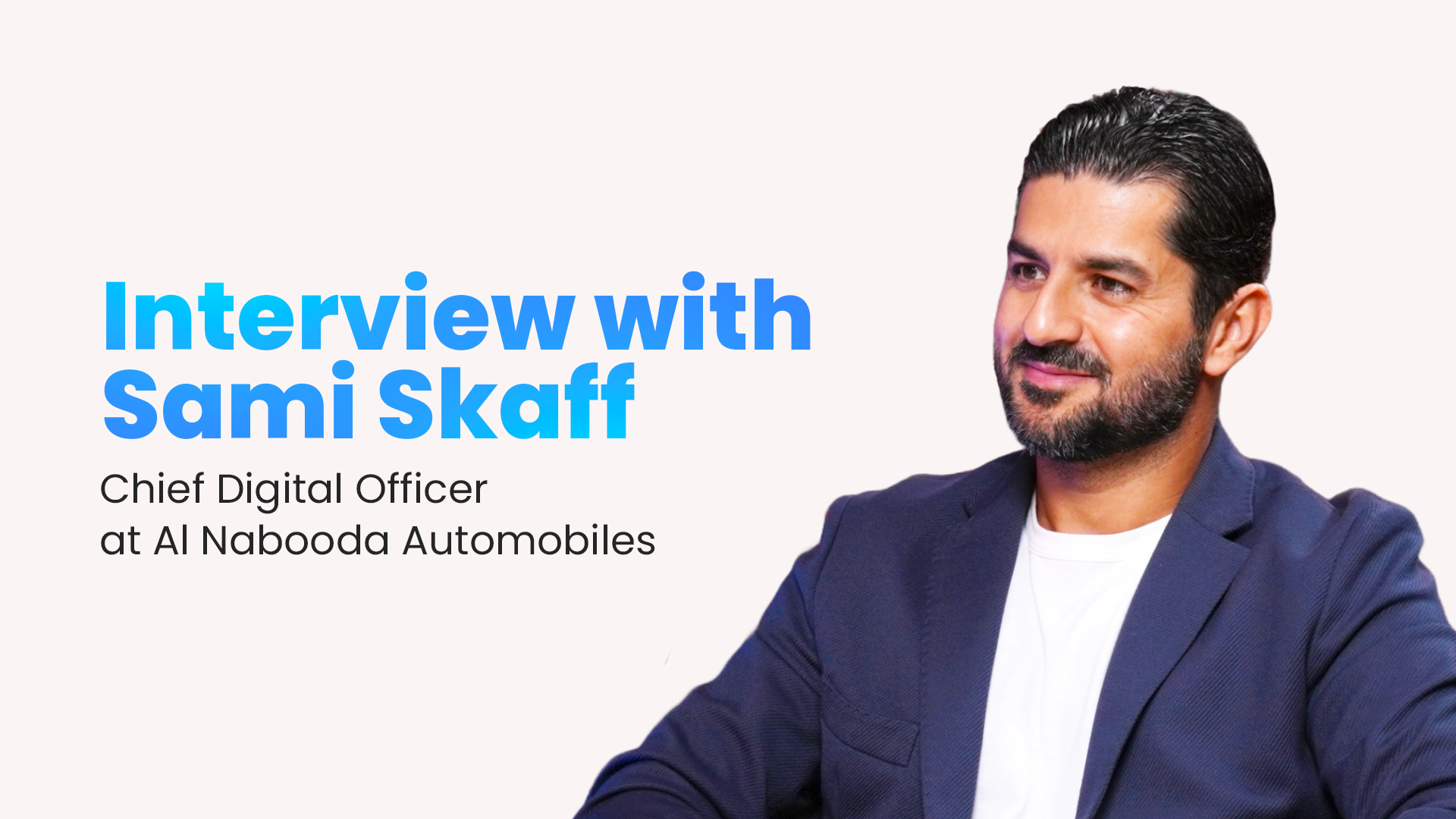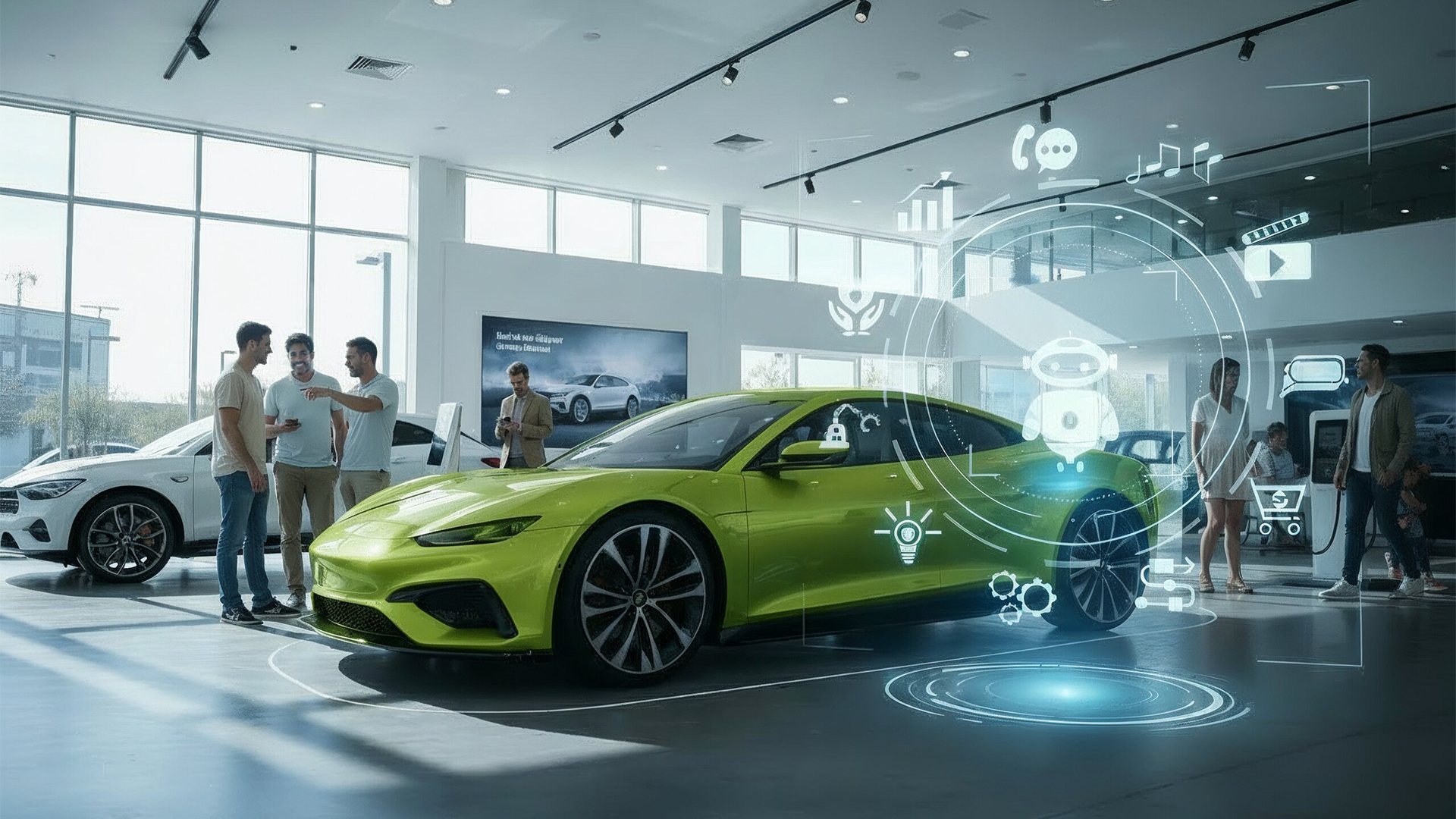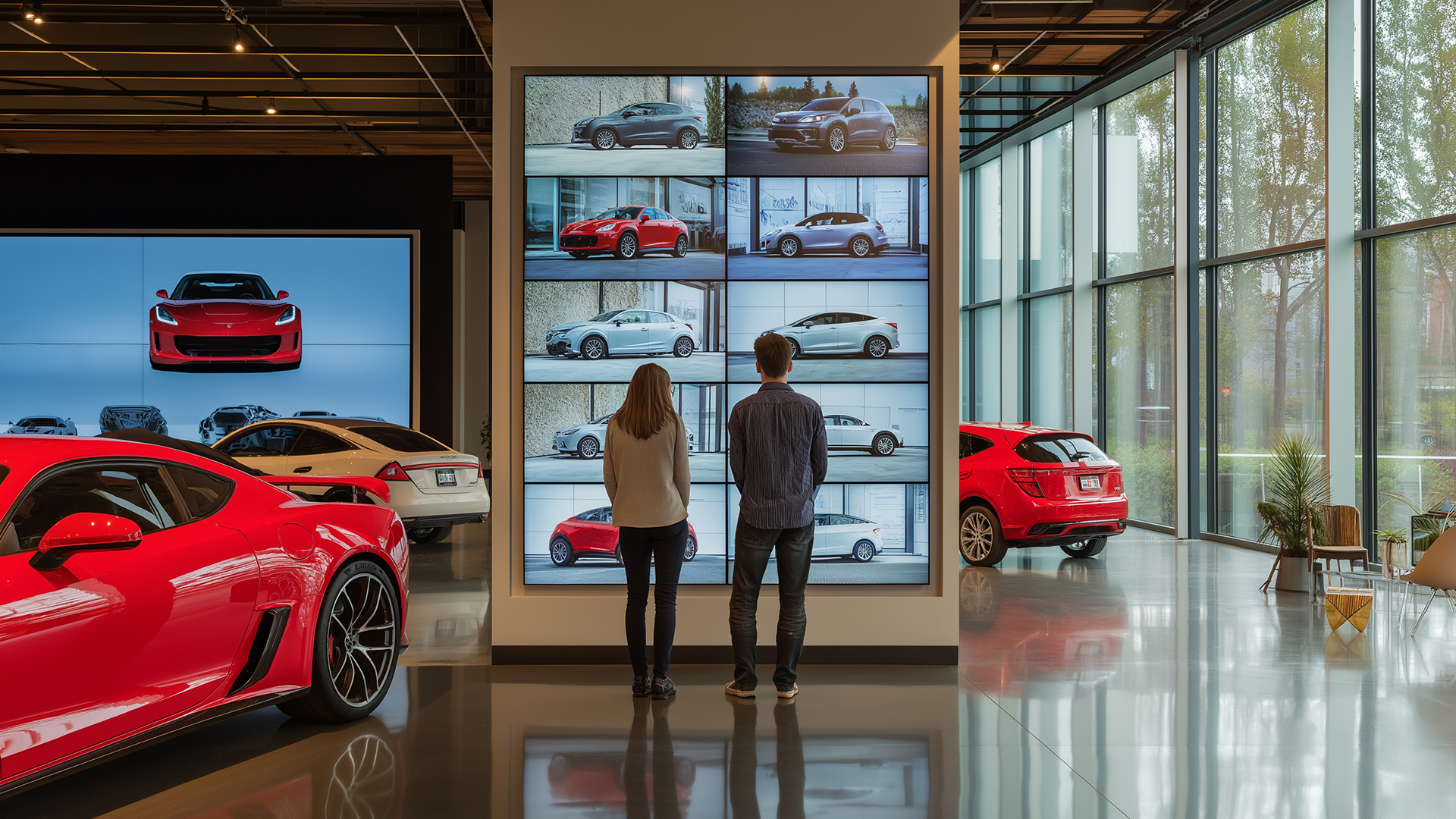Staying ahead of the curve isn’t always easy, so how do you future-proof the world’s most iconic automotive brands? For Sami Skaff, Chief Digital Transformation Officer at Al Nabooda Automobiles, it’s all about blending speed, innovation, and a deep understanding of what today’s customers expect. Whether it’s bringing AI into the service experience, navigating the EV influx, Sami is driving big change behind the scenes. In this episode, he shares how his team is reshaping the customer journey and why the next decade in automotive is set to be anything but ordinary.
Part 1: Actionable Digital Wins
Digital transformation goes beyond listing cars, it touches CRM, inventory, and customer support. What have been your and Al Nabooda Automobiles’ priorities?
At Al Nabooda Automobiles, we’ve taken a deep approach, looking all the way from the manufacturer to customer delivery, and even into aftersales, parts, and trade-ins to keep the cycle going.
For me, the first priority is always to fix the basics. In a large operation like ours, that means making sure sales, after-sales, parts, marketing, CRM, and the call center are all functioning smoothly, that’s the foundation we build on. But alongside that, you need what I call “thirst killers” which are small innovations or use cases that create excitement, show progress, and offer a glimpse of what’s possible with new technology, like AI. It’s not just about using AI for the sake of it, but identifying where it can truly improve our operations.
What’s equally important is taking an iterative approach. We start small, test new ideas, and if they work, we scale them up. If they don’t, that’s okay, we treat it as a learning opportunity. This mindset is crucial because digital transformation also means driving cultural change. In traditional organizations, failure has often been seen as something to avoid, but in digital, small failures can actually help move things forward faster. It encourages teams to experiment, learn, adapt and ultimately that’s what gives us an edge and helps us keep evolving.
Some companies struggle with “too much data, not enough action.” How do you make sure your digital strategy actually drives results?
It always starts with the use case. In a long-established organization like Al Nabooda Automobiles, it’s normal to have siloed or messy data; that’s just how technology has evolved over time. But you need someone to connect the dots and think about how that data can be used to drive meaningful outcomes. Right now, we’re focusing on internal and customer data, which is already in our DMS. The next step is advancing with CRM, marketing cloud, and segmentation so we can actually act on that data. One of our top priorities is customer segmentation and data cleaning. For example, we have niche brands with niche audiences, so accuracy matters, even down to how a customer’s name is spelled. In the past, you’d see names entered inconsistently, and that affects personalization. If you can’t address a customer properly, your communication will feel impersonal and irrelevant. That’s why clean, structured data is so critical and we’re actively working on that now.
We always approach this through a use-case lens. Rather than trying to tackle everything at once, we focus on the specific outcome we want, whether it’s boosting revenue, improving customer experience, or ensuring compliance. These are the three key pillars that guide any initiative. We also take a growth hacking approach: we test, learn, and scale what works. If something doesn’t work, we adjust. That’s how we make sure data turns into real results, not just more noise.
Part 2: Old Practice, New Expectations
In your opinion, what’s the biggest “ancient practice” in car sales that needs to go?
The automotive industry has always taken a very engineered, linear approach. You build the car, hand it to the dealer, and they sell it. Even though digital tools are available today, many companies are still treating digital the same way: a top-down, one-way process. But digital doesn’t work like that; it’s non-linear, it involves testing, analytics, and constant adaptation, especially because we’re now dealing directly with end customers online. One big shift that’s overdue is decentralizing digital at the operational level. Yes, we must follow the brand’s CI (corporate identity) and guidelines, but we also need to give dealerships more freedom to experiment and engage with customers. Dealership teams understand their local audience better than anyone, and they should be empowered to try new digital initiatives whether that’s testing new content formats, embracing trends like UGC, or improving the online customer experience.
Today, most automotive websites are still very static, they don’t reflect the same premium, “hotel-like” experience that brands invest in at their physical showrooms. For me, the website is the virtual showroom, and we need to bring that same energy and attention to the digital experience. Until we loosen some of the top-down control and let dealerships innovate more freely, we’re holding back real progress.
In your opinion, what’s one customer expectation that has changed dramatically in the last five years?
In digital, there’s a lot of “let’s try this,” “let’s test that,” and that mindset is essential for any company today, especially with so many new players entering the market and moving fast. Speed has become key. If you look at Dubai, for example, you get things done on the fly, sometimes even faster than in countries we consider advanced. Consumers in the UAE are used to that level of service, with companies like Amazon setting the bar, so speed combined with a great experience is now non-negotiable.
At the same time, people still want to feel taken care of by humans, we’re all human at the end of the day, and that emotional connection matters. Another big shift is that customers no longer have the patience to repeat themselves. What really creates a “wow” experience is when your systems can predict the next best action, and that only comes when you have the right data in place and can truly understand the customer journey.
Part 3: Future Proofing Car Sales
What are some of the biggest innovations you’ve introduced to enhance the way customers interact with your brands at Al Nabooda Automobiles?
We’ve been focusing on the basics first, like process automation, and AI is playing a major role in that. One of the key use cases we’re working on is using AI to improve customer communication, for instance, when customers are due for their next service. We’re also using AI to optimize parts availability, something that has been a challenge in the past.
Once these basics are in place, we’ll be able to take it a step further, optimizing the next best action for each customer to ensure we’re providing timely, relevant experiences. Customers today simply don’t have the time to wait, and their expectations have shifted, especially after COVID, when everything from grocery shopping to healthcare went online. The pace of change has accelerated, and even with big-ticket items like cars, that online engagement is now part of their everyday expectation. We need to be there, meeting them where they are.
As part of our roadmap, we’ve implemented Seezar in our call center. We’re starting internally, following our usual dipstick approach, which involves testing and learning before scaling. Already, it’s helping our agents quickly address customer queries, which customers really appreciate because they want fast answers. It’s also helping us onboard new agents much faster. Eventually, we hope to extend it directly to customers, so we can keep raising the bar on speed and experience.
Where do you see the differences usually between a dealership’s requests vs what a user might actually need when interacting with Seezar?
EVs are already starting to take over a big share of the market, and that’s only going to accelerate. But beyond that, connected cars will be a game changer. As a petrolhead, I love the sound of a roaring engine, but the shift we’re seeing now is all about connectivity your car will be linked directly to the dealership, which will prevent many issues before they even happen. This will improve the lifetime value of the car and significantly enhance the customer experience.
Imagine being alerted before a part starts to fail, or having genuine spare parts automatically ordered when needed. It’s similar to what’s happening in healthcare, where AI can now detect early signs of diseases like cancer, giving us a huge advantage in treatment. Prevention is always better than repair. So in the future, before your brakes wear down or your spark plugs fail, the system will already have it covered. And when you combine that with conversational AI, smart agents, next-best-action recommendations, and optimized offers, you’re delivering a level of convenience that lets customers truly relax. They won’t need to worry about their cars, we’ll be managing the entire journey, from buying to servicing to trading in.
Part 4: Chinese Brands and the EV shift
How do you envision the growth of EVs in the coming years?
EVs are here to stay, and their growth is inevitable, but it all comes down to having the right infrastructure. In places like Dubai, we’re already ahead of the curve, with charging stations available at most petrol stations. But the real race now is about how fast we can charge. You can fill up a petrol tank in two minutes; to match that convenience, EVs need to get to that same level of speed or at least offer solutions for long journeys where fast charging is available.
Another key point is range, not just under ideal conditions, but also during peak summer, when running the AC increases consumption. That’s going to be an important differentiator.
I also see a shift in how service centers operate: they’ll be less about fixing mechanical issues and more about software updates. The business model will evolve toward monetizing those updates, much like how we see with smartphones today. There’s huge potential for innovation as well, for example, EVs can help with driver identification so that the vehicle knows exactly who’s driving. Plus, blockchain can play a role in the used car market by storing a transparent, tamper-proof vehicle history, making resale easier and more trustworthy.
Chinese EV brands like Nio and Xpeng are entering global markets aggressively – do you think they will be a serious threat to legacy brands?
We’re definitely seeing Chinese brands making their presence felt in the market. Traditionally, consumers were loyal to American, German, Japanese, and later Korean brands and if we look at how Korean brands evolved, they came in, proved their value, and are now seen as top-tier players. I think we may see a similar trajectory with Chinese brands. Right now, there’s an influx like we’ve never seen before; it’s mushrooming. But over time, the main players will emerge, just like we saw with the Koreans.
The legacy brands we work with are already recognizing this shift. One thing about the Chinese brands is that they’re incredibly hardworking and fast. They operate with a startup mindset, but on a massive production scale. This creates real competition.
For established brands like Porsche, Audi, Volkswagen, and McLaren, it’s no longer business as usual. They understand they need to rethink their approach, especially with EVs. The revenue model has to change, you’re no longer relying on things like oil changes for aftersales revenue in the EV era. So, the challenge is: how do we adapt to this shift and prepare for the future? I believe the answer will lie in a hybrid approach because combustion engines won’t disappear overnight, but the landscape is definitely changing.
Part 5: Chinese Brands and the EV shift
Where do you see AI having the biggest impact on the automotive industry in the near future?
AI is already transforming the way we work, and it’s only going to accelerate from here. One of the biggest impacts I see is how AI boosts productivity, it’s like having one person deliver the output of a 10-person team. But it’s not just about using AI tools; it’s about having the maturity to work with them effectively and putting the right guardrails in place.
Today, it’s no longer just about communication or leadership skills; you need AI skills to stay relevant in this era. Even my nine-year-old is asking ChatGPT questions! AI helps you move at incredible speed, keeps your teams lean, and ultimately makes you more competitive. Upskilling your team in AI will be key to staying ahead in the automotive industry and really, in any industry.
Sami’s final ‘brake’ down:
At the end of the day, it’s about making things simple, fast, and human. In a place like the UAE, where speed and convenience are everything, you can’t afford to waste a customer’s time. Whether it’s using AI to predict their next service or making sure parts are ready before they even ask, we want to stay one step ahead. That’s why I always say: ask for feedback, don’t assume. The Mom Test is a book I always go back to, as it teaches you how to ask the right questions and actually listen. That’s how we grow. Not just by adding more tech, but by solving the right problems.



